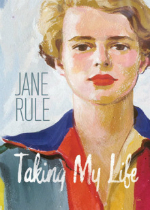 Taking My Life
Taking My Life
by Jane Rule
Talon Books. 280 pages, $19.95
BORN IN AN ERA when lesbianism was considered deviant and unmentionable, Jane Rule grew up to write books in which same-sex love was portrayed as sane, nurturing, and entirely normal. How she came to question and subvert the dominant culture as she eventually did is the subject of Taking My Life, a memoir that covers the first 21 years of Rule’s life. Discovered among her archived papers after her 2007 death, the memoir has been brought to print by scholar Linda Morra.
Jane Rule was born in New Jersey in 1931, but moved to Canada in 1956 and thereafter identified as a Canadian writer. Her 1964 first novel, Desert of the Heart, which is about two women who fall in love in Reno, Nevada, in the 1950’s, was made into the groundbreaking cult classic film Desert Hearts in 1985. It remains the most popular lesbian movie of all time. Rule enjoyed a long and successful career both writing and teaching, and she received many awards. She also enjoyed an enduring relationship with Helen Sonthoff, whom she met when both were faculty members at a private school in Massachusetts in the 1950’s. They lived together until Rule’s demise.
When writer Katherine Forrest called Rule “arguably the most significant lesbian writer of the 20th century,” it’s unlikely that she had in mind Rule’s prose style, which was direct but unremarkable. It was her vision of women’s lives and relationships that was extraordinary. Rule didn’t posit an idealized lesbian utopia. Her characters were flawed and complex, and they often clashed with the bigotry of the dominant culture.
Taking My Life is just a draft, not a completed work, much less a polished one. Rule writes as if talking to herself, sketching the basics with the intention of returning to rework and reshape the material at a later date. Events are dropped into the narrative with little build-up or explanation. For instance, Rule’s acquiescence, as a virgin, to being pressured into having sex with the husband of the woman she loves seems unfathomable but goes unexplained. “I had no way to refuse him,” she writes. But why? This passivity is particularly perplexing in light of a story Rule had told only a few pages earlier about a man she was dating who actually pulled a gun to coerce her into having sex. She told him off, outraged, and he put the gun away.
Despite these limitations, there is a wealth of information here about Rule’s early life, including her strong, loving family, her sense of loss when the close bond she shared with her older brother doesn’t endure, her troubles in school (“I tended to comic insolence”), and her often anxious and neurotic behavior. Her relationships with three women with whom she fell in love while coming of age are explored at length. She experienced these first loves as positive and nurturing, while only too aware that they defied convention and possibly the law. About her early attraction to other women, Rule reflects: “I seemed to hold two mutually exclusive views, that my love represented what was best in me and that it was a sin.”
A turning point came during a confrontation between Rule and her first great love, Ann Smith. Smith takes Rule as a lover but insists that Rule try to fall in love with a man in order to avoid becoming a lesbian. Unhappily married and suicidally depressed herself, Smith claims to despise her life as a woman. Rule protests: “I told her I was a woman and loved my life.” But: “To that she replied that I didn’t yet live in the real world. I told her I never intended to.” In fact, through her books, Rule creates a world in which she can survive and thrive.
If Taking My Life has a hero, it is Rule’s fiercely supportive and cheerfully unconventional mother. “Don’t learn to do anything you don’t like,” she advises her daughter, “or you’ll end up having to do it the rest of your life.” When Rule frets about ending up an old maid, her mother responds: “Who you want to be is what’s important. If someone comes along to share life with, fine. It’s not something to worry about.” Rule’s mother defends her behavior at every turn. Carlotta Jane Hick Rule modeled defiant nonconformity for Jane while resisting any attempt to force her daughter to conform. Having a mother like that clearly made it easier for a deep-voiced, six-foot-tall teenager to feel comfortable in her own skin.
The definitive biography of Jane Rule still needs to be written. With any luck, the publication of this memoir will inspire a qualified scholar to undertake this task. In the meantime, Taking My Life is a gift to Rule’s fans, who will relish the opportunity to enjoy a unique voice that we didn’t think we’d hear from again.
________________________________________________________
Roz Warren is the editor of Dyke Strippers: Lesbian Cartoonists from A to Z. She maintains a website at www.rosalindwarren.com.





